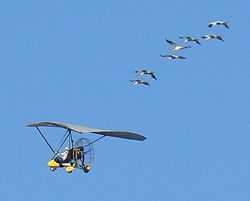Bill Lishman
Bill Lishman is a Canadian inventor, artist, and ultralight aircraft enthusiast.
Artist
Lishman created two sculptures for the Medieval Faire section of Canada's Wonderland, as well as some smaller works for application to the buildings. The most prominent is a dragon at the entrance to the Dragon Fire. Originally intended to hold a sign, park management decided they liked it enough as a standalone sculpture. He was allowed to design it from scratch, as opposed to follow preset designs established before he was hired. The sculpture took him and assistant Richard Van Heuvelan two months. The other sculpture was the wild boar at Wild Beast, both of which were built at his home in Blackstock, Ontario, for about $75,000. Signs by Lishman included Sherwood Florist,[1] Boo Boo's Buggys, an ice cream cone, and for a popcorn counter.
Gliders and ultralights
Lishman started out by flying a motorized ultralight fixed-wing glider called the UFM Easy Riser, a bi-wing craft designed in California by Larry Mauro as a hang glider. Bill practiced foot launching from his back yard (a 100-acre (0.40 km2) wooded lot with a large hill at one end) with varying degrees of success. Steering on the Easy Riser was controlled by two drag rudders, mounted between the wingtips. To turn, the pilot twisted the bars under his armpits from which the pilot hung. Pitch control was by shifting the pilot's body-weight: leaning forward made the airplane pitch down for more speed; and leaning backward made it pitch upwards and slow down.
Tired of endlessly hauling the glider back up the hill, Bill took the next step and bolted an 8 horsepower (6.0 kW) go-kart engine on to the back of the hang glider (thus forming an ultralight aircraft), carved himself a propeller and in 1978 made Canadian aviation history by becoming the first in Canada to foot-launch a rigid-winged powered ultralight aircraft.
Operation Migration

During the late 1980s and early 1990s, Lishman openly wondered if waterfowl could be taught new migration patterns by following low-speed ultralight aircraft. In 1993, after several years of logistical and bureaucratic setbacks, Lishman successfully led a flock of Canada geese on a winter migration from Ontario, Canada to northern Virginia. Of the sixteen birds that participated in the migration, thirteen returned to Ontario the following year - entirely on their own.
Operation Migration was co-founded by Bill Lishman and Joe Duff in 1994 and registered as a charity in Canada and a 501(c)(3) nonprofit in the United States. Following the successful experiment with Canada geese, the team turned their efforts to rare and endangered species. Richard Van Huevelen, who assisted Bill in many of his sculptures, is one of the most valuable team members.
In 1999, Operation Migration, led by Joe Duff, was asked by the US Fish and Wildlife Service to spearhead an attempt to reintroduce whooping cranes into eastern North America. As of 2012, the team continues to lead a new generation of whooping cranes on their first migration with the goal of establishing a self-sustaining flock by the year 2015.
The 1996 movie Fly Away Home was loosely based on Lishman's early work, including his book Father Goose, published in 1995.
Lishman's ideas are credited as an inspiration for the French film Winged Migration.[2]
Underground house
Lishman designed and built an energy-efficient underground home in Blackstock, Ontario.
The home has eight connected pods, each with a skylight, with three dedicated to sleeping space. One is large enough to hold forty people. The home is built on a hill where one can view Lake Scugog. The pods are domes and were constructed from reinforced concrete, given a tar coating, and buried in sand. A rubber sheet was laid over the sand before the area above the home was covered by topsoil which supports a lawn and garden. Lishman says the home was inspired by Roger Dean when the family was displaced from their converted schoolhouse home in the way of the proposed Pickering Airport. The home has been occupied since the summer of 1991.[3]
Photographs of the layout of the eight pods during construction and of an interior dining space are posted at a dome-centered site.[4]
Personal life
He lives in Blackstock with his wife Paula Lishman, a fashion designer and president of the Fur Council of Canada. The Lishmans have two sons, Geordie and Aaron, and one daughter, Carmen.
Sources
- Lishman, William. Father Goose. Crown, 1996. ISBN 0-517-70182-0.
References
- ↑ McDonald, Jane (5 May 1981). "Blackstock sculptor builds a dragon for Wonderland". Toronto Star (Toronto ON). p. ES09.
- ↑ "Making of" special feature on the DVD
- ↑ Zekas, Rita (14 January 2013). "Paula Lishman and Bill Lishman go underground". Toronto Star. Retrieved 25 November 2014.
- ↑ Bill Lishman's Canadian Compound from Domeontheweb.com